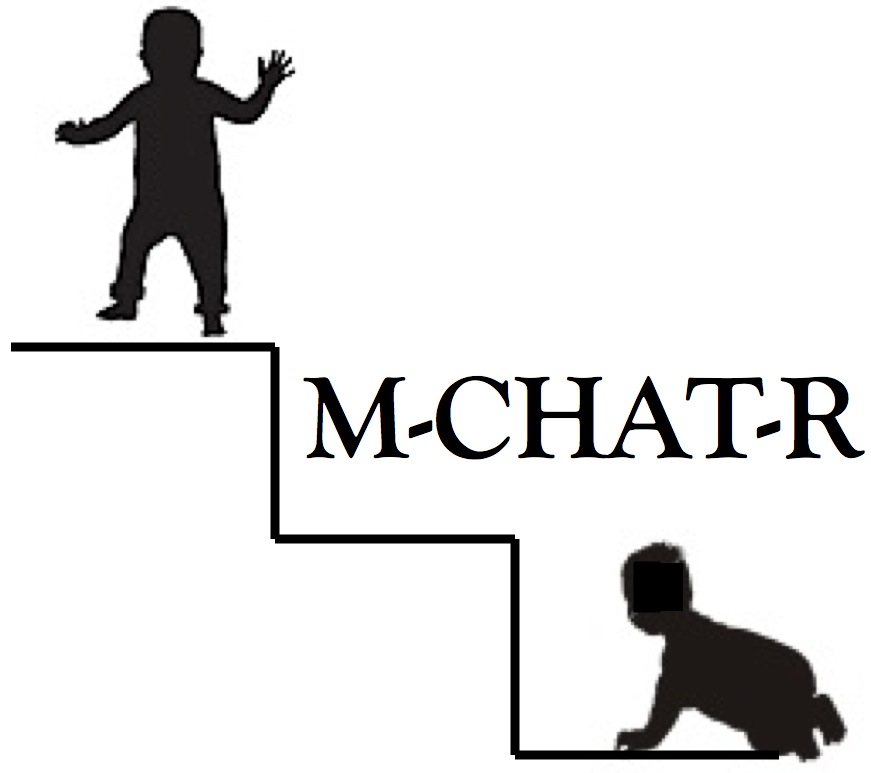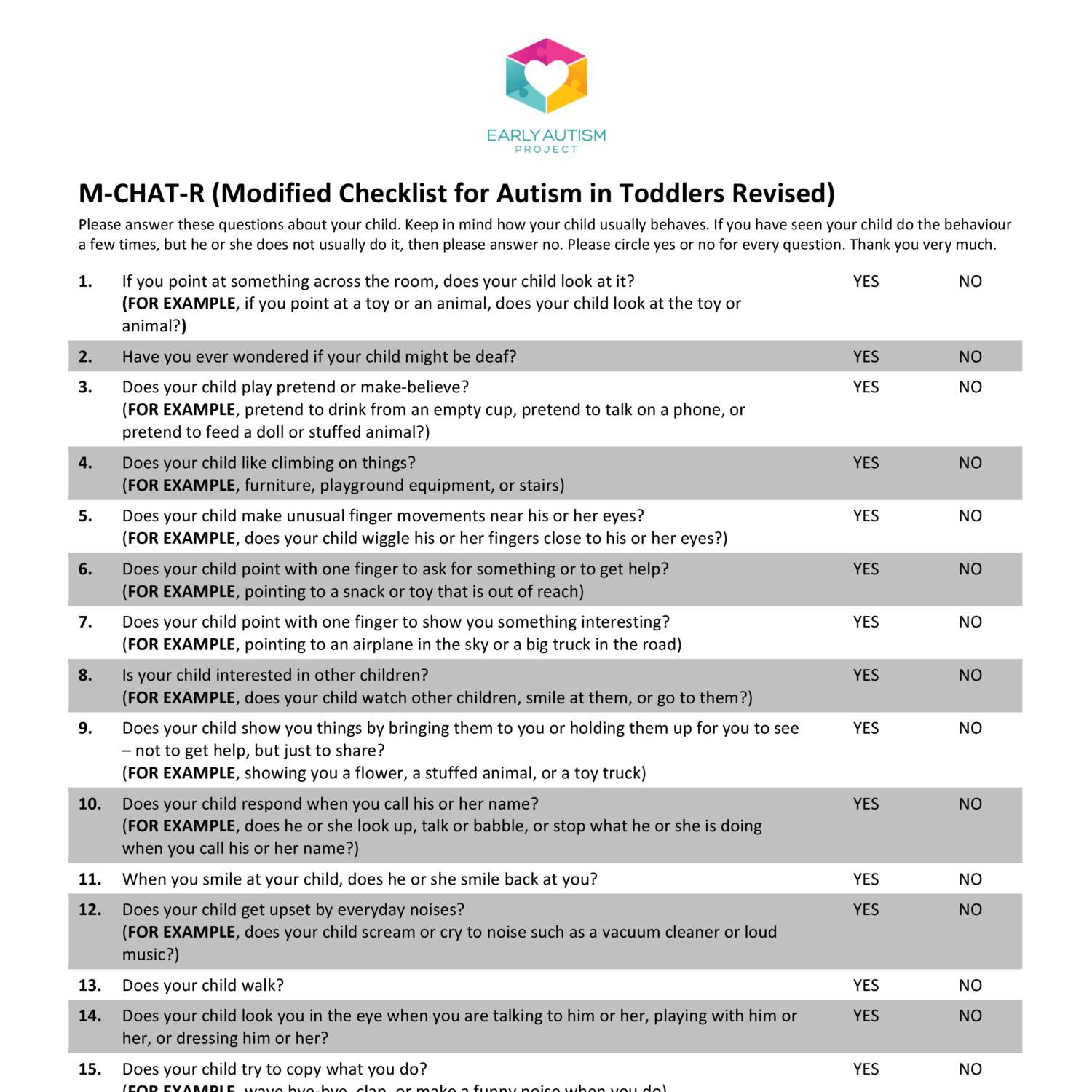M-Chat-R Printable - Therefore, there is a high false positive rate, meaning that not all children who score at risk will be diagnosed with asd. If the behavior is rare (e.g., you've seen it once or twice), please answer as if the child does not do it. Keep in mind how you child usually behaves. Does your child enjoy being swung, bounced on your knee, etc.? However, the questionnaire yields a very high rate of. Sensitivity = 91%, specificity = 95%. A scoring overlay and an microsoft excel scoring program. If you have seen your child do the behavior a few times, but he or she does not usually do it, then please answer no. It has been found to accurately identify children on the autism spectrum before they are of concern to parents or professionals. Please answer these questions about your child.
MCHATR logo Pedijatar.mk
If you have seen your child do the behavior a few times, but he or she does not usually do it, then please answer no. Keep in mind how your child usually behaves. Robins, fein, & barton, 1999) is available for free download for clinical, research, and educational purposes. Does your child enjoy being swung, bounced on your knee, etc.?.
Cuestionario M CHAT
It has been found to accurately identify children on the autism spectrum before they are of concern to parents or professionals. Please try to answer every question. Does your child enjoy being swung, bounced on your knee, etc.? Keep in mind how your child usually behaves. If the behavior is rare (e.g., you've seen it once or twice), please answer.
_references Reference, Version, Assessment
If the behavior is rare (e.g., you've seen it once or twice), please answer as if the child does not do it. Please circle yes or no for every question. A scoring overlay and an microsoft excel scoring program. Please note, printers often make minor adjustments. If you have seen your child do the behavior a few times, but he.
SciELO Brasil Tradução para o português da escala MCHAT para
Web license inquiry permission required for books and articles: Please answer these questions about your child. It has been found to accurately identify children on the autism spectrum before they are of concern to parents or professionals. A child whose score was greater than 3 at the first screening (18 months) and greater than 2 at the followup (24 months).
MCHATR_WebV1.pdf DocDroid
If you have seen your child do the behavior a few times, but he or she does not usually do it, then please answer no. For pediatric primary care physicians: Robins, fein, & barton, 1999) is available for free download for clinical, research, and educational purposes. Please try to answer every question. Does your child enjoy being swung, bounced on.
wpcontent uploads 2015 09 MCHATR_F.pdf Termine
Therefore, there is a high false positive rate, meaning that not all children who score at risk will be diagnosed with asd. Email use that does not require permission: Please download this document for instructions for use. Keep in mind how your child usually behaves. If you have seen your child do the behavior a few times, but he or.
Cuestionario de Autismo en la InfanciaModificado (MCHAT)
Please answer these questions about your child. Does your child enjoy being swung, bounced on your knee, etc.? If you have seen your child do the behavior a few times, but her or she does not usually do it, then please answer no. It has been found to accurately identify children on the autism spectrum before they are of concern.
Print Version Lineagen MChat Chat, Print, Version
For pediatric primary care physicians: Please note, printers often make minor adjustments. Please circle yes or no for every question. Therefore, there is a high false positive rate, meaning that not all children who score at risk will be diagnosed with asd. Please answer these questions about your child.
Venkovský dům Mchat score 5
It's intended for toddlers between 16 and 30 months of age. Keep in mind how your child usually behaves. The checklist is quick and easy to fill out by many parents, with a literacy level cited at the 6th grade, and the scoring is straightforward. Please note, printers often make minor adjustments. If the behavior is rare (e.g., you've seen.
Mchat Printable Printable Word Searches
It has been found to accurately identify children on the autism spectrum before they are of concern to parents or professionals. Please note, printers often make minor adjustments. Therefore, there is a high false positive rate, meaning that not all children who score at risk will be diagnosed with asd. For pediatric primary care physicians: It is intended to be.
To facilitate scoring, two documents are available for free download: If the behavior is rare (e.g., you've seen it once or twice), please answer as if the child does not do it. However, the questionnaire yields a very high rate of. Please note, printers often make minor adjustments. Please circle yes or no for every question. Therefore, there is a high false positive rate, meaning that not all children who score at risk will be diagnosed with asd. Keep in mind how your child usually behaves. Sensitivity = 91%, specificity = 95%. If you have seen your child do the behavior a few times, but he or she does not usually do it, then please answer no. A scoring overlay and an microsoft excel scoring program. Please download this document for instructions for use. A child whose score was greater than 3 at the first screening (18 months) and greater than 2 at the followup (24 months) had a 47.5% risk of being diagnosed with autism spectrum. If you have seen your child do the behavior a few times, but her or she does not usually do it, then please answer no. Email use that does not require permission: Keep in mind how your child usually behaves. Does your child enjoy being swung, bounced on your knee, etc.? Robins, fein, & barton, 1999) is available for free download for clinical, research, and educational purposes. Please try to answer every question. Please answer these questions about your child. It has been found to accurately identify children on the autism spectrum before they are of concern to parents or professionals.
A Child Whose Score Was Greater Than 3 At The First Screening (18 Months) And Greater Than 2 At The Followup (24 Months) Had A 47.5% Risk Of Being Diagnosed With Autism Spectrum.
Please note, printers often make minor adjustments. Please download this document for instructions for use. Please answer these questions about your child. If the behavior is rare (e.g., you've seen it once or twice), please answer as if the child does not do it.
A Scoring Overlay And An Microsoft Excel Scoring Program.
Sensitivity = 91%, specificity = 95%. Please answer these questions about your child. Therefore, there is a high false positive rate, meaning that not all children who score at risk will be diagnosed with asd. Keep in mind how you child usually behaves.
It Is Intended To Be Administered By A Trained Health Care Professional.
If you have seen your child do the behavior a few times, but her or she does not usually do it, then please answer no. The checklist is quick and easy to fill out by many parents, with a literacy level cited at the 6th grade, and the scoring is straightforward. Please try to answer every question. To facilitate scoring, two documents are available for free download:
Robins, Fein, & Barton, 1999) Is Available For Free Download For Clinical, Research, And Educational Purposes.
Please circle yes or no for every question. It's intended for toddlers between 16 and 30 months of age. Keep in mind how your child usually behaves. Does your child enjoy being swung, bounced on your knee, etc.?









